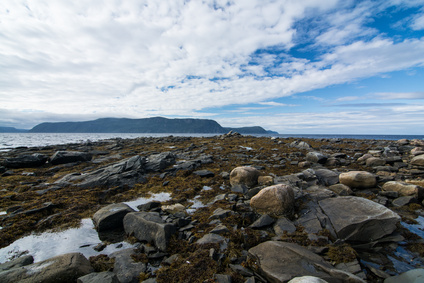Learn Geography Online
At first glance the Lake Melville Geological map of scale 1:250 000 the area appears to be heavily areal scourged in the Mealy Mountains plateau and uplands south of the inlet. Though this is not entirely verified. Some in the Geo-morphology field suspect that the Mealy Mountain peaks remained not glaciated during the late Wisconsinan glaciation period (Wisconsinan glaciation 85,000 to 11,000 years ago) Some evidence supporting this opinion is found in a carbon date of 21,00 year BP by H.E. Wright Jr. (University of Minnesota 1979) near lake Melville. This is not totally reliable due to the possibility of older carbon contamination.
Some in Geo-morphology suggest that the Wisconsinan ice may have reached only 710-555 meters in elevation in the Mealy Mountains. This is roughly 1700 -2200 feet. On the topographic maps various ridge like grooves aligned in a north-east south-west direction support this opinion. These grooves are filled with lakes. The highest surface elevation is 1700 feet. Everything over this elevation seems to have been untouched.
The plateau area does not have the long grooves depressions but does have a few Roch Mountonees with the roughened sides facing eastward. ice flow could have come from the west or possible the south as the drumlins would indicate.
The uplands areas around Eagle River do not show any glacial erosion features, the land being around thousand feet in altitude and relatively flat. The Eagle River does not show any U-shaped valley characteristics.
The mid latitude areas contain far more oval and rounded hills with river valley such as the Main Brook and north River. this is characteristic of selective linear erosion and could have happened during advance or retreat of the ice.
The conclusion is the landscape is divided up into six drainage basins and five topographical landscapes. At first glance the area does resemble a deranged drainage topography which is characteristic of areal scourging. Roche Mountonnees with their steep facets facing eastward along with many drumlins with theirs crags facing southward. This indicated that ice could have come from the south or possibly the west. However the with drumlins it is generally unclear because the can form during glacial retreat as well. It is generally believed the ice flow in the Lake Melville area was eastward and flow was controlled by the Mealy Mountains. Some in the field of Geo-morphology believe that these mountains divided the flow and lake Melville itself became a calving bay. If the area did remain ice free than the moraines and drumlins should date earlier than the Late Wisconsinan.
